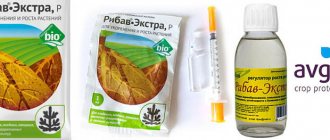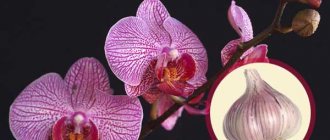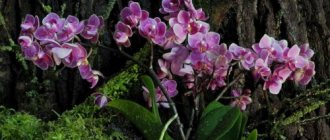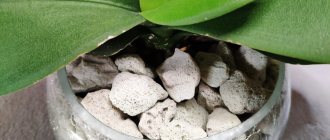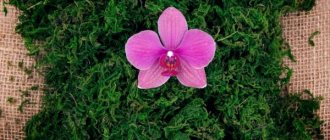Our apartments have completely different conditions to which the orchid is accustomed to in its homeland, which means that the gardener will have to work hard to achieve bright flowers and full-fledged shoots. Substrate, watering and fertilizing - these are the “three pillars” on which the care of the capricious beauty rests.
The main problem with feeding orchids is that they react to organic matter and folk remedies differently than the usual ficus or Kalanchoe. A solution of bird droppings, ash or onion infusion will cause an orchid that is not accustomed to such a “menu” to get sick or even die. Therefore, do not rush to “feed” her along with the rest of the inhabitants of the windowsill.
Artificial stimulation of an orchid
Artificial stimulation in growing orchids is used to provoke the plant to bloom.
No matter how ideal the conditions for their cultivation may be, no matter how competently and clearly the feeding system is thought out, there are times when orchids need to be pushed to begin flowering.
Artificial stimulants are used for this.
Cytokinin paste when diluted
Cytokinin paste is very convenient and easy to use for orchid propagation. This action is best done in late winter or early spring. At this time of year, the plant has the maximum amount of vitality.
Cytokinin paste can only be stored in the refrigerator.
Using a knife, scratch the surface of the peduncle and apply 2mm of paste there. After 10 days, a bud will begin to emerge on the stem. To awaken the bud, you need to cut off the scales and spread the paste again. After about 10 days, the bud will wake up, when the first leaves appear, transplant it into a pot.
From the video you will learn about the use of cytokinin paste on orchids:
Main types of plant growth stimulants
Auxins
These are widely known phytohormones that enhance the flow of water and nutrients dissolved in it into plant cells and contribute to their proper redistribution. In the plant, it is produced and accumulated in the cells of the root system, at the apical points of the plant, allowing it to actively grow.
When there is a lack of lighting, treatment with this hormone promotes “stretching” on the darkened side , preventing unnecessary, aesthetically imperfect bends.
The influence of auxins.
Important! Auxins should be used with great caution, observing very precisely the proportions and dosage. The slightest mistake can lead to the opposite effect and even inhibit the development of the orchid.
Gibberellins
Gibberellins are plant hormones that regulate plant growth, stem elongation, seed germination, and flowering . This hormone is located in dormant kidneys, therefore, when its concentration is increased artificially, their development is stimulated.
Thus, when an orchid is treated with gibberellin, the development of the flower bud, the formation of buds and flowers is accelerated; they can become larger and display brighter colors. Not only does the flower develop, but the growth of leaves and peduncles also increases.
Along with the active development of the above-ground part, gibberlin provokes the development of cells of the root system , which is important, given that many orchids have a photosynthetic root system and with an increase in the total photosynthetic area, the growth of the plant as a whole is naturally activated.
The influence of gibberellins.
Cytokinins
Cytokinins are another type of phytohormone, increasing the concentration of which in the plant:
- stimulates the formation of buds, and, accordingly, the activity of flower formation;
- promotes the opening of stomata, that is, it activates the plant’s respiration process;
- provokes the growth of lateral buds in the presence of dominant apical growth.
They are successfully used for vegetative propagation of plants.
The influence of cytokinins.
Important! Cytokinins require great care when working. Personal protective equipment is required. Be sure to put the drug in a place inaccessible to children!
Feeding rules
Healthy, strong, brightly flowering plants cannot be obtained without the use of nutrients and fertilizers, preferably of natural origin. Orchid owners believe that abundant flowering can be achieved by adhering to some feeding rules:
- adding substances 2 weeks before the start of bud setting;
- compliance with proportions, concentration, dosing of nutritional compositions, otherwise you can cause harm and burn the roots;
- due to the specifics of the soil, use fertilizers only in liquid form;
- a recently acquired flower cannot be fertilized or replanted;
- It is not recommended to feed weak, painful, transplanted orchids;
- lack of fertilizing compounds during the dormant period;
- nutrients are applied only to moist soil;
- The fertilizer composition used for the first time should be tested on one flower (in case of a negative reaction).
The need for replenishment can be understood by the appearance of the orchid. The signals are:
- pale, yellowish leaf color;
- slow or lack of growth;
- lack of flowering;
- falling leaves and unopened buds.
Root formers
To enhance the development of the root system, when necessary, it is recommended to use root stimulants, such as:
- Kornevin;
- Embiko;
- Ribav-Extra.
The main component of all these drugs is the orchid growth hormone heteroauxin , which promotes accelerated growth and development of root cells.
Heteroauxin is added to all root-forming preparations.
In addition to it, fungicides are added to the preparations , preventing the development of pathogenic microflora, or a starting set of microelements, which ensures healthy, full-fledged cell growth.
When using Kornevin powder, it is recommended to dilute it with crushed activated carbon, which acts as an antiseptic and is used to prevent the occurrence of fungal and bacterial diseases of orchids.
Vitamin cocktails
Vitamins can be used as stimulators for the development of orchids , such as:
- thiamine – vitamin B1 , which increases the size of flowers, stimulates the development of the root system, and slows down the aging of the orchid;
- Niacin – vitamin B3, improves reproductive function, accelerates the onset of flowering. It is often used when it is necessary to revive a diseased plant;
- pyridoxine – vitamin B6 , improves adaptation after transplantation, used for flowers that are recovering from illness;
- cobalamin – vitamin B12 , stimulates photosynthesis, saturates cells with oxygen, normalizes plant growth after stress.
To prepare a vitamin cocktail, you need to mix two or more of these drugs and treat them.
Brief overview of stimulants
Growth and development
Ferrovit
This drug enriches the plant with iron , which can increase the amount of oxygen supplied to the cells and activates the healthy growth of the plant.
Epin
Epin strengthens the plant's immunity , increases resistance to pathogenic organisms, and stimulates the development of buds and flowers.
Epin.
Augustine
The main active ingredient is chitosan , which promotes long-lasting bright flowering, active root growth and increased immunity of the orchid.
Tsitovit
Contains the most important microelements that stimulate the development of the orchid and activate full, abundant flowering, improves immunity, and brings the orchid out of the “frozen” state.
succinic acid
Succinic acid acts as a catalyst for those orchids that, for one reason or another, have stopped growing or stopped blooming, and also strengthens the immune system , removing the orchid from a state of stress.
Succinic acid is widely used in the resuscitation of orchids.
Vitalizer HB – 101
A very popular biostimulant that promotes the active development of buds, increasing their number, as well as promoting the formation of large, bright, numerous flowers .
Root growth
Kornevin
Activates the growth of cells of the root system , is used to resuscitate orchids whose roots have been lost as a result of infection with fungal microorganisms.
Cytokinin paste
Cytokinin ointment for growth activates the process of cell division, catalyzes the regeneration of plant tissues, and is often used for successful vegetative propagation of plants.
Cytokinin paste is also used for reproduction.
Maksim
The roots of orchids are treated with a solution of this drug when fungal diseases occur. It acts as an antiseptic and at the same time stimulates the development of new cells .
Optimal conditions for flowering
In order for the buds to bloom faster, you must follow a number of rules for caring for the flower. It is important to maintain optimal temperature conditions. Some flowers can grow at temperatures of +50, and most varieties do not tolerate temperatures above +25. Therefore, before purchasing an orchid, you need to read more about the conditions under which it is kept. In addition, the flower does not tolerate temperature changes well.
Lighting has no less effect on the flowering of an orchid. In winter, the flower should be illuminated with halogen, fluorescent or mercury lamps up to 40 W. The orchid must receive lighting at least 14 hours a day. Do not place the pot next to radiators in winter.
The orchid should be watered while strictly observing the temperature regime in the apartment. Otherwise, the flower simply will not bloom due to stress. Water the delicate exotic only with water at room temperature. Some species growing in warm countries, on the contrary, prefer watering only with hot water no more than 45 degrees. But all varieties of domestic flowers should not be watered with cold water. Moisture from the roots should completely drain.
The flower feels comfortable at room humidity of at least 60%. Humidifiers help make the air moist; you can often wipe the leaves, wash them, or spray them with a spray bottle. Spraying is carried out with soft, settled water. You can use melt water. The smallest nozzle on the spray bottle should be used so that the moisture is sprayed in a cloud over the plant. Additional moisture is possible if the grower places a tray of water next to the pot.
For an orchid, caring for the root system is important. If the roots die, the plant will simply wither. Therefore, it is so important to water the orchid correctly and provide the roots with good air exchange. If the plant is grown in a transparent container, this makes it easier to monitor the condition of its root system. Healthy roots have a green tint. With a lack of water they become whitish. Watering is done when the roots turn white. If they turn brown, it means the roots are rotting or drying out. You can use a root growth stimulator to feed the roots.
Why doesn't the orchid bloom?
How quickly the flower blooms may also depend on the age of the orchid. Perhaps it is too young, and the first flowers appear on an indoor pet after 1.5-3 years. A plant ready to flower will have five to eight shoots.
A moved pot can also be the reason why the plant does not gain color for a long time. The orchid perceives changes in lighting negatively. If you urgently need to move the pot, then you should leave the same side of the plant illuminated as before. It is better to grow in a transparent glass pot with holes in the bottom.



